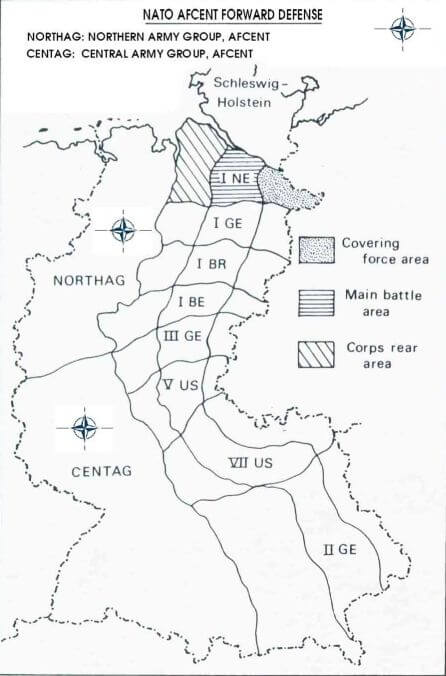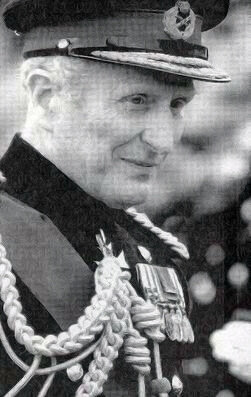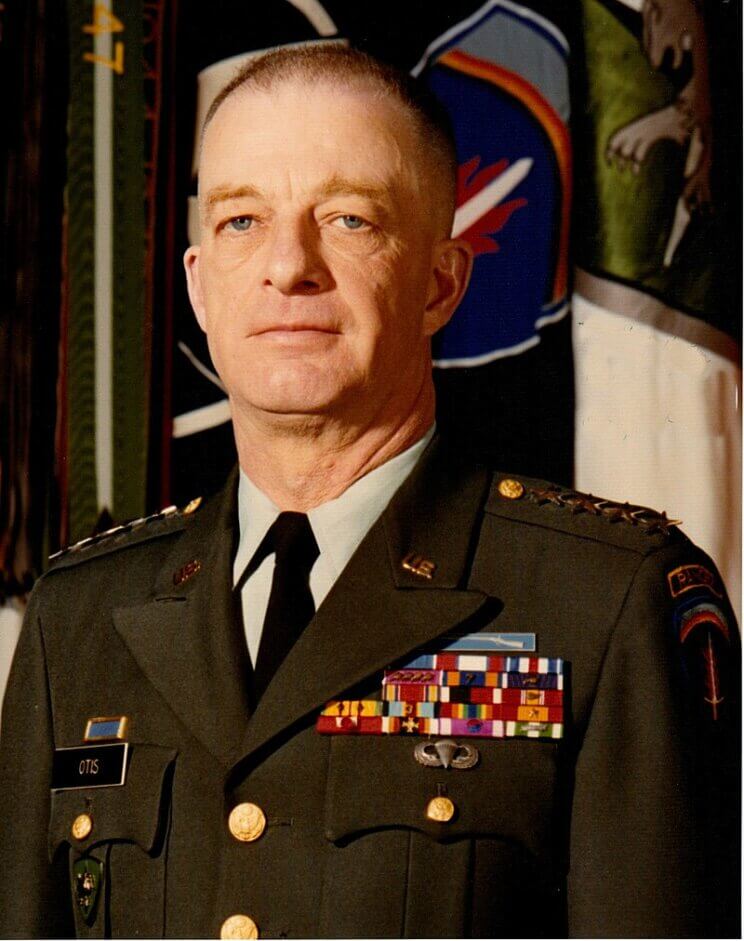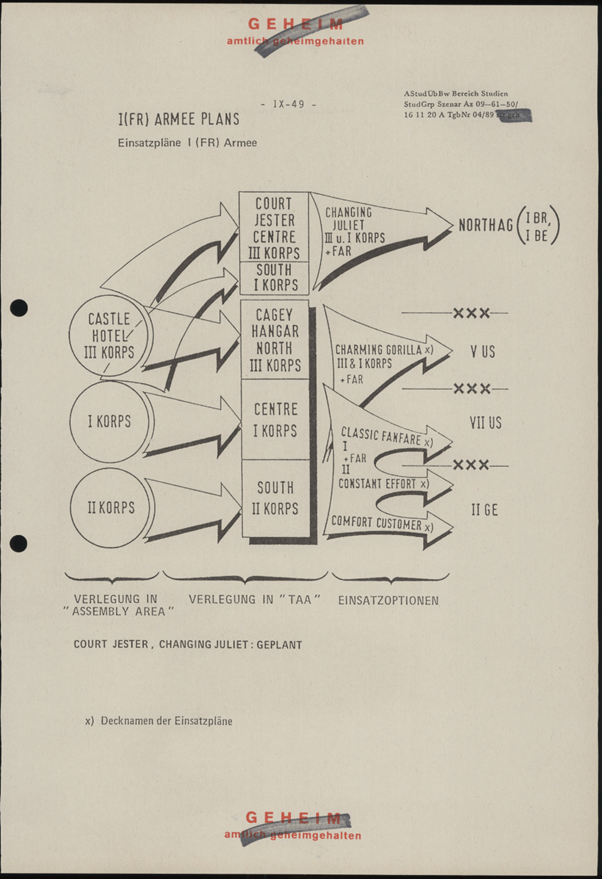Developer’s Notes by Anthony Morphet
For those new to Thin Red Line Games who don’t yet know me. I am a gamer of some 50 years’ experience but also a retired British Army Colonel who spent most of his junior service in BAOR until I attended the German Staff College and served as a General Staff officer in various NATO HQ.
4th Game in the C3 Series – What’s the Problem?
Fabrizio describes how he entered this game design and development process completely secure in the knowledge that all problems were solved and there were no further surprises, only to be completely surprised by the problems we faced. I thought I knew the challenges ahead, how wrong I was!
The first and biggest challenge was to ensure that the whole team understood the NATO command state structure. Something many officers to this day still don’t fully grasp.
NATO has four principal command states that are relevant here; The command state is the defined authority that the nation owning a military unit gives a commander to change the unit’s composition, orders and tasks.
FULL COMMAND is the authority to hire and fire personnel and kit, to decide where a unit goes, and what it is to do when it gets there. As a rule, it is retained by a nation’s Head of State, and exercised by the Minister of Defence and never delegated.
OPERATIONAL COMMAND (OPCOM) is the highest authority ever delegated and it is almost never given to an organisation that does not belong to the country that owns the unit. In a British Division the GOC (General Officer Commanding) will probably have OPCOM over the Brigades and other units in the division. OPCOM allows the commander to change the composition or ORBAT of the unit and to give it any mission or task he desires.
OPERATIONAL CONTROL (OPCON) is the authority that NATO commanders hold over their subordinates. The commander may not normally change the composition of the unit but he may give it any missions that are relevant to its role. This functions differently at different levels. SACEUR, even a 4-star US General, cannot change VII Corps mission from defending its Area of Responsibility to send it to NORTHAG as a reserve without authority from the US that retains OPCOM. Similarly, the Commanding General of VII Corps can’t make 12 Pz Div give up 35 Pz Gren Bde to under command 1 (US) AD as he is not allowed to change the unit’s organisation. In summary missions and tasks can be given within role, but changes of role or organisation are not allowed.
TACTICAL CONTROL (TACON): Under this authority a commander may change neither the organisation nor the mission of the unit. He may give it further tasks and add support but fundamentally he can’t change the baseline organisation.
Corps Layer Cake – National Slices, a Well Known Fact

The Central Front GDP was called a layer cake because each Corps was completely self-sufficient within its borders and there was absolutely no overlap. The map seen here shows it perfectly. It also illustrates the point that Fabrizio made on the length of the Inner German Border (IGB) the VII (US) Corps had to defend.
In developing this series of games “known facts” tend to blow up in your face and this was no exception. VII Corps and its planners were faced with a number of problems: In peacetime 2 ACR was not big enough to monitor this length of border and thus it had a Squadron of 11 ACR from V (US) Corps under command. A bigger problem was created with the withdrawal of US forces in 1968 and replacement with the REFORGER programme. The removal of 2/3 of a division meant that VII Corps did not have enough troops to defend its area prior to reinforcement. Major problems to be resolved.

In 1985 NATO had as its Army Group Commanders on the Central Front two extremely clever, forthright and effective Generals. NORTHAG had General Sir Nigel Bagnall and CENTAG had General Glenn K. Otis. Both men assumed command of their Army Groups in 1983 and both realised that they could not fight an Army Group led battle unless aspects of NATO doctrine changed – a highly political decision. They both lobbied hard for change and both achieved great success.
In NORTHAG Bagnall secured the use of 7th German Panzer Division as an AG reserve under OPCON to his HQ and with authority to use it throughout the AG area.

In CENTAG Otis secured a different and at times more complicated change. He had a small reserve already; the Canadian 4 CMBG. He was also promised the French First Army (1 FFA), more of which later. His major problem was to cover the shortfall of troops in VII Corps area until 1 (US) ID could arrive from CONUS, break out its REFORGER equipment and deploy to the operational area.
He lobbied for and in 1985 was granted OPCON of the bulk of 12th German Panzer Division. The division was based in peacetime within VII Corps AOR minus its 3rd brigade (34th Panzer Brigade) which was based in Koblenz. This latter was retained by the Korps Commander of III (GE) Korps as his designated reserve. To give 12 Pz Div a third brigade, 1 (US) ID Forwards was placed under TACON.
Whilst this resolved the troop numbers problem, it brought with it a huge number of interoperability issues. In addition to the language barriers these included, but were not limited to:
- Differing command philosophies. In 1985 the US still used a very strict top down directed command system. The Germans used a very flexible but language specific mission command system.
- Differing comms systems that did not directly interface with each other at all levels.
- Differing artillery firing methodologies which eventually led to the US designating and specifically training 72 Field Arty brigade to fire in support of the division.
- Very differing combat support philosophies.
Gradually these problems were overcome by a mixture of liaison teams, training, technical solutions and most importantly of all a gradual change to the deployment and lay down of the Corps over each new iteration of the GDP between 1985 and 1989. However in 1985 these problems were acute.
Formations – Equipment, Numbers, Where, When and How?
The two key western protagonists in this module are VII (US) Corps and parts of 1st French Army. In both cases we needed to know strengths, dislocations, equipment types and numbers. As well as their plans and command relationships to NATO higher commands. In both cases the information was incredibly difficult to find and sources were often contradictory. After considerable digging we have located enough information to be sure of our findings.
The Americans
In the US discovering the issue programmes for equipment such as M1 Abrams tanks, or even the upgrading programme for M60 from A1 to A3 standard were inordinately difficult. We never found full programme plans but achieved success via various other means. In terms of documentation and maps relating to the General Defense Plan (GDP) we had to rely on copies from German sources as the US copies remain very difficult to access.
The French
We were also searching for similar information for the French Armed Forces. The French definitely have this information but such things as the AMX 30B2 issue programme is still classified. Here too, several unpublished German documents helped out and we are confident that the ORBATs we present here are correct and accurate.

The graphic on the right shows potential French deployments, and the code names for possible counterattack operations. Although it is dated 1988 or 1989, the baseline thinking for these deployments began in 1985. In essence the French Government had placed 1 FFA TACON to CINCENT. The NATO commander needs to be very sure that the French are given a task they can deal with as reinforcing or supporting them with non-French units can be extremely difficult.
Implications for the Rules System
We were very keen not to rewrite any core rules and as ever we were also keen to ensure that the player was faced with the appropriate level of decision making. To that end the problems raised by these issues are resolved as follows:
- 2 ACR border surveillance: After considering various options it was decided that as NATO had had 24 hours of military preparation time the squadron would have already redeployed to the V (US) Corps AOR, covering the Bad Neustadt – Bad Kissingen area. This gave birth to the Warsaw Pact Entry rule, also having consequences on the Warsaw Pact Supply Sources.
- The issue of differing US and German command philosophies would have such a severe impact on the time taken to generate and distribute orders, meaning that the Germans must lose the benefits of Mission-Type orders as outlined in rule 6.1.4. We decided that we would not restrict the use of US artillery assets to named units. All artillery and AH in VII Corps can support 12 Pz Div.
- The French and their use provoked an awful lot of discussion. Not the least of which was which units would arrive when. In the end, the French Separate Command rule was devised, de facto limiting French units to only receiving French combat support and vice versa.
- Engineers and Electronic Warfare can only be allocated to an HQ with the owning HQ’s nationality (Nations are notoriously sensitive about SIGINT/EW).
In Summary
Accurately representing the complexities of the command relationships between differing national C3 systems took a lot of time and effort and I still bear the scars. However I am sure it works and it works properly.
As the developer I am happy that the series rules are solid and a great foundation and yet once again we have produced another game with a distinctive flavour that separates it substantively from all its predecessors including its fellow Americano-centric cousin “Less than 60 Miles”. I hope you will agree with me and enjoy playing “In a Dark Wood” as much as we did in designing and refining it.
Alas, the conception that the squadron of the 11th ACR stationed in Bad Kissingen is not correct after 1975/76. When LTG Starry assumed command of V (US) Corps, the squadron was returned to the 11th ACR where I was stationed from JAN 1977 to DEC 1979 and the covering force consisted of the three 11 ACR squadrons, two divisional cavalry squadrons, and 3 tanks infantry Task Forces.
I served with officers while in the 1ID(Forward) who had been in the 2nd ACR and some remembered “rumors” of a fourth squadron but none believed that it was OPCON or attached to 2nd ACR or another unit. In addition I contacted officer who served with the squadron and none ever indicated they were under the control of 2ACR or VII Corps.
However, the 11ths border patrol duty not only covers the V (US) sector, but also went North into III (GE) and somewhat into VII (US) and a div cavalry squadron was also used by 2ACR for its own patrol area.
BK was in the VII Corps sector, and V Corps had to pay it rent.
On a lighter note in 75/76 the USAREUR basketball tournament was held in BK between the BK based squadron and a VII Corps squadron. Both corps commanders and the USAEUR commander attended, and VII Corps was most upset the Blackhorse Squadron won.
When I was working on
Hi Mike,
always good to get eye witness accounts. I probably did not phrase this as well in the piece as I could, for which I apologise.
The point I was trying to make was that VII Corps did not have enough assets in place in peacetime to cover the missions required in peacetime and war and in particular in the period of transition to war. In peacetime the lack of troops to cover the IGB within sector was achieved by having a squadron of 11 ACR patrol part of VII Corps area – my understanding was and remains that in 1985 these missions were at least controlled by VII Corps staff in peacetime. However as the force transitioned to war the command relationships reverted to those to be used in the war. The key take away for this game is that by D Day the command relationship is quite clear and all of 11 ACR is under V Corps command.
However that still had implications for this game. Not the least was that one of the main WP access routes into VII Corps AOR is crossing the corner of V Corps AOR. We had to reflect that and the potential impact upon Warsaw Pact Lines of Communications by V (US) Corps for this game to function properly as a stand alone.
We did not want to increase the map size and neither did we want to add elements of V Corps already represented in Less Than 60 Miles. Therefore to solve this problem it was necessary to write the WP supply rule, representing the delay and covering battle being fought by 11 ACR as part of V Corps to the north of this map.
I hope that clears any misunderstandings and thank you for the feedback.
Tony
PS. Please ignore the sentence fragment at the end. Also note that the 1 ID(F) was OPCON to 12 PzD, a fact that tended to dismay the 1ID(M) CG when tthey visited us.
Over the years the OPCON/TACON discussion was up and down and at one stage became quite complicated with I ID Fwd, 9 CE Bn and 72 Fd Arty Bde under three differing command states to 12 Pz Div.
I remember doing a 100KM mounted road march during training with 12 Pz while I was in 1ID (F). Good times!
1988-1990 with 1st ID(f) as Support Operations Officer and as DTO. We did a couple of command post exercises with 12th Panzer, but were mainly self-contained in our logistics, and our task forces always trained with just our organic units. At the time, had the balloon gone up, none of us expected to be around to greet 1st ID (M). They probably would have been shoved into a gap or put into reserve in the war we imagined. (Of course, GSFG and the USSR NCA imagined a different war commencing with massive nuclear strikes on Wedy Germany, Belgium, and the Netherlands.
George, as you pointed out, the US 1ID Forward logistic was “self contained” – in game terms it needs US supply and cannot use the WG one.
I beg to differ on its survival chances, at least in a non-integrated battlefield. I think most of the brigade would have been alive and kicking when the rest of the division arrives.
George,
My view is not too far away from Fabrizio’s. I do not think you would have disappeared in a nuclear fireball within the first “x hours”, pretty sure that Moscow had given up on that idea by 88-89. I do believe you might have had your gas drills well tested though! However I suspect that if we had only had 24-48 hours mil prep time and 12 Pz and you fellows were more or less doing OK then the rest of your division may have been filling a hole somewhere else and it would have been a while longer than expected before you joined up with each other.